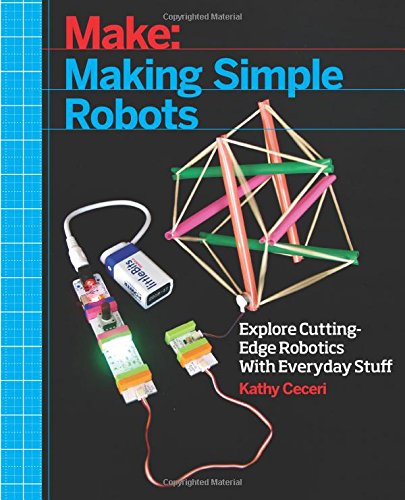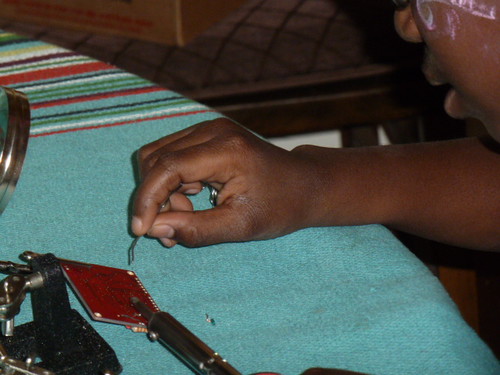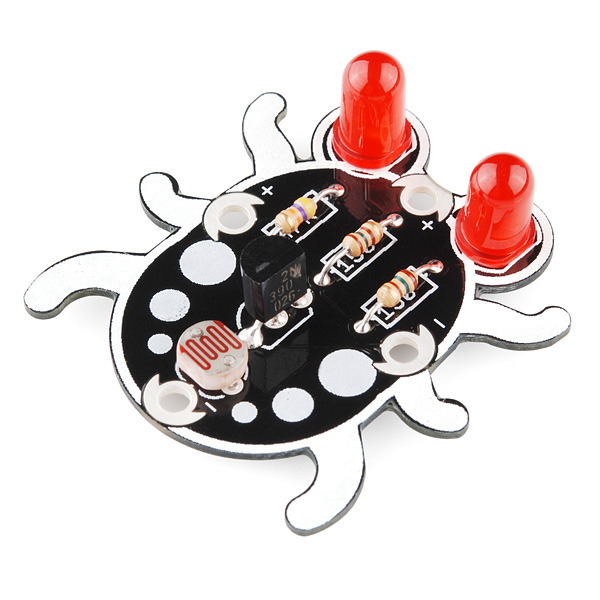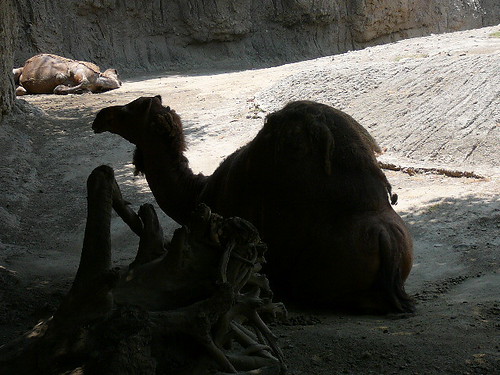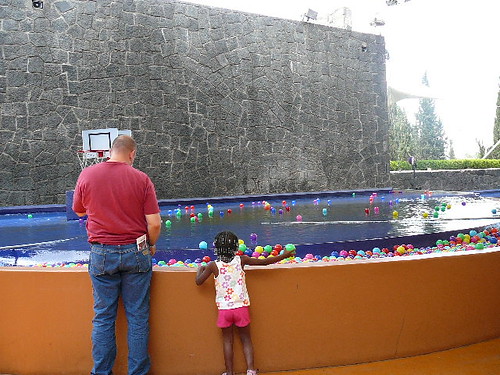Recently we took our seven (nearly eight) year old granddaughter to Mexico City for a week and several folks have expressed surprise that there was anything for a child to do there. In fact, it was the second time we'd taken her to Mexico City - the first time she was four - and there are plenty of things to do with young kids. Moreover, the subway system makes the city super easy to get around, at least for most tourist purposes.
I've already written about Mexico City's
wonderful children's museum, El Papalote, which ended up absorbing a couple of days of our most recent, kid-centric trip. Here are a few other kid-friendly things to do in El D.F.:
Zoo in Chapultepec Park
The zoo in Chapultepec Park is excellent - probably too big to get through in a day with a small one - and makes a great in-city day trip. It's easy to reach via the metro. It's a short walk from the metro stop to the zoo entrance but you can ask anyone for directions or, on weekends, just follow the crowd with kids who migrate there in great numbers every Saturday and Sunday. The zoo is free but some special exhibits require a (relatively cheap) ticket. There's a food court on the grounds; skip the US brands there and go for the Mexican sandwiches, tacos, etc.. is my advice.
Alternatively, the exit to the zoo dumps you out next to several rows of food booths where you can eat
comida corrida style (a cheap, fixed price, multi-course meal). There's a little merry go round there, a mirror maze, a playscape, and small train that circles around part of the park that you can get on near the food stalls. My suggestion: Get something at the food stalls in the zoo, look at animals till you've worked up an appetite, then head to this food area for a satisfying late afternoon meal in a relaxed atmosphere where there's something for kids to do.
Be forewarned, the main paths to and especially from the zoo and in Chapultepec Park generally on the weekends are lined with innumerable vendors selling snacks, drinks, trinkets, face paint, plastic superhero or princess-themed toys, etc.. Consider yourself miraculously lucky if you get past them without reaching into your pocket. (And some items, like face paint or
agua frescas are hard to say "no" to on a fun family day.) For kids old enough to add and subtract, consider giving them a small sum they can spend on trinkets or snacks every day and let them choose what it is. It's inevitable, so why not do it in a way that teaches some responsibility and leaves you out of the decision making surrounding every 10 peso transaction? That strategy worked out well for us on our most recent trip.
The Zocalo
The zocalo in Mexico City is a massive open square with a large cathedral on the north side and the national palace on the east. There's no telling what's going on there on any given day, but there's usually something. The church is worth visiting and the sidewalk outside includes not just the usual trinket and snack-sellers but opportunities to receive a shamanic blessing by women in traditional native garb waving smoldering handfuls of sage around their customers.
The Diego Rivera murals in the national palace may be about all the art viewing many young ones can stand. We found that, with some effort, Ty could follow the grim storyline Rivera related about the Spanish conquest and the people's uprising during the Mexican Revolution. But she was more interested in the (admittedly amazing) cactus garden behind the small courtyard housing the famed murals. In the daytime, take a frisbee to throw out in the square, or maybe a kite, for the bold - there's a surprising amount of wind there most times of year.
For us, though, the best part of visiting the zocalo was at night. Here's how I described these outings
in another venue:
Just for fun, we took some light-up garb with us to Mexico City to the zocalo after dark: The granddaughter's hoodie with EL Wire stitched around the edges, a few dozen small glow sticks, a couple of balloons with flashing RGB LEDs
inside them, and three battery operated EL Wire strands long enough to
use as a jump rope, one of which ended up lining a hat. Folks approached
in gaggles wanting to buy one or the other of the light-up goodies,
with somebody offering five times for a strand of EL Wire what I'd paid
for it. We gave away glow-stick bracelets to the kids and referred
would-be customers to the websites where I'd bought them. (This was a
great way to meet families with kids, btw.) When it was bed time, the
young'un gave away the balloons with flashing LEDs to a couple of little
girls in the square and distributed the last of the glowsticks to a
passel of teenagers before she turned, hoodie flashing, and we walked
back through the seemingly ever-present multitude to our hotel.
The walk from our hotel to the square was a pedestrian-only street jam-packed with people. Every few yards you'd see people elaborately dressed as cartoon characters, superheroes, or monsters looking for people to pay ten pesos (about 77 cents) to take a picture with them. You can get an ice cream or other sweet and walk up and down people and building watching, window shopping, and soaking in the experience of being in the center of one of the planets most populous, vibrant cities.
Teotihuacan
A visit to the pyramids at Teotihuacan is a standard tourist day trip from Mexico City. But I must confess, I have mixed feelings about taking young kids to ruins sites. Ty has been to both Teotihuacan outside of Mexico City and to Chichen Itza in the Yucatan. Chichen Itza was a complete bust - she was more interested in the bark on the trees than the pyramids we were there to visit. Teotihuacan, too, was a little much for her. She was interested at first and had fun climbing over and under things, where it was allowed. But the outing took too long and by the end we had quite a grumpy girl on our hands. OTOH, she remembers both outings fondly, especially Teotihuacan, and her account of the episode after the fact included none of the complaints that seemed to dominate the day. Go figure.
The problem with taking kids to such places is they have no history nor context for what they're seeing and there are more things they can't do ("don't climb," "don't touch") than things they can. If you go, take snacks, water and head coverings (no shade at Teotihuacan), and maybe a ball, frisbee or other toy for a bit of play time.
Market day
I'm sure locals become numb to the experience, but to me, after dozens of visits over the years, a large Mexican market is still like a wonderland - certainly that's true the first time you go through it. There's a large market just southeast of the zocalo in Mexico City
that's perfectly located for the first-timer or the hundredth alike, but
of course there are many others scattered around the city. Be sure and
ask a local for a recommendation and travel directions, though. Some are
sketchier than others.
Shop for whatever you're personally after but stop whenever the young one wants to look at toys, snacks, etc., she potentially could afford. After all, what's the use of walking through a wonderland if you're not allowed to stop and gawk? Pro tip: Give the kid a (slightly larger than the usual daily) allowance
and tell them they get to decide how to spend it. Then you're not to
blame when they can't have something. And don't forget you can buy ridiculously inexpensive kids' clothes while you're there, much more cheaply than even discount stores in the states.
Eat a big breakfast before you go then in the afternoon eat
comida corrida in the market. If you're still hungry, there are dozens of stalls with treats, fruits, and all manner of goodies that will delight any palette. Don't neglect the street stalls surrounding the market; if it looks clean and there are lots of locals standing in line, it's a pretty good bet.
If you're staying somewhere with a kitchen, consider spending an evening where you buy food from the market and cook it yourself (ideally channeling your internal
Diana Kennedy). Most American kids aren't used to seeing food that fresh go straight from the butcher or the farmer's stall to the dinner table and it'll memorably reinforce what they saw during their market visit.
Xochimilco
When the Spaniards
first arrived, Mexico City was built on a lake and the Aztecs moved
people and goods about the town through canals on barges and boats.
Today, Xochimilco on the outskirts of town is one of the last areas
where the old canals still stand. Saturdays are the big day when there
are lots of food vendors and mariachis in the water. We didn't go this time but took Ty when she was four. Great family atmosphere.
You can rent a boat (including somebody to row) and take a tour up the
canals, buying food from boat-bound vendors (or bringing your own) and
paying for the occasional tune or three from mariachi bands floating in
their own boats alongside you in the canals. This area is filled with
flower nurseries and you can stop whenever you want to look at them,
have a picnic, etc., though of course be careful of US import
restrictions if you decide to buy any flora. (Cut flowers to spruce up the hotel room can be nice, though.) A trip to Xochimilco makes
for a lovely, unique family afternoon and getting there is pretty easy
via public transit, as described in any decent guide book.
KidZania
We ended up not going because of time, but the
KidZania franchise
started in Mexico City
and has become a mainstay of local kid entertainment. Our hotelier with
a young kid and some of their staff with children highly recommended
it, though looking online there are criticisms about excessive
commercialism, etc.. Somebody must like it, though. Franchises have
sprouted up all over the planet and locals say their children enjoy the
place. Maybe next time.
Eating out
The good news: In Mexico, there's seemingly no such thing as a non-kid friendly restaurant. If you want to go there, odds are nobody will think twice if you bring your children with you. There are numerous, terrific breakfast places in
El Centro, as well as spectacular bakeries. Also, the coffee situation has much improved: Nescafe is becoming rare (previously the only version of coffee you could get) and there are even Starbucks dotting the landscape here and there.
You can't go wrong taking a young'un to the tile-covered Sanborns across from Bellas Artes, with its amazing floor to ceiling murals and
fun kids' dishes. (The food is good but not spectacular; you're going for the atmosphere.) When we were there three years ago, one of the waitresses wanted her picture taken with our granddaughter. When we returned this time, she recognized her, gave her lots of hugs and attention, and asked us to return the next day when she brought the old photo and had Ty write her name on the back and take another one. Utterly charming.
We also enjoyed Cafe Tacuba, a beautiful old place filled with lovely paintings, murals and an amazing array of stained glass art over the front door. The mariachis there were excellent, as was the food. (In recent years, I've begun skipping Plaza Garibaldi for listening to mariachis - there are typically fine groups playing in and around many restaurants and Garibaldi, while famous, has become a bit seedy if you're taking kids, recent government efforts to renew the area notwithstanding.)
If you choose, you can spend as much money on a meal in Mexico City as one might in a fancy restaurant in New York or London. However, some of the best eating in Mexico happens at food stalls on the street or tucked away in the markets. Perhaps my favorite meal of the trip was when Ty and I got giant, delicious quesadillas filled with chicken, queso and and a thick tomatilla sauce and ate them in the park. Afterward, we played hide and seek for a bit, then she took off her shoes and played in a fountain with a couple dozen other kids. I wouldn't have traded that afternoon for the finest gourmet meal in the city.
Traveling with kids: A philosophical choice
The missus and I have a working theory about traveling with kids. If you're going the bring them on vacation, the vacation is going to be about them. Sure, we might enjoy visiting the National Anthropological Museum or the Modern Art Museum in Mexico City, both of which are spectacular. (We've returned to the Anthropological Museum repeatedly as we've traveled around Mexico and learned more indigenous history; a lot of the best artifacts from every corner of the country are there.) Over the years, we've spent lots of time walking around outlying neighborhoods, visited Frida Kahlo's home, the wonderful Dolores Olmeda museum, and even the house where Leon Trotsky was assassinated. But such outings won't hold a young child's interest for more than a few minutes. After that, every moment can be a struggle if a child is bored or just doesn't want to be there. Force the issue and it's easy to make everyone miserable.
If, on the other hand, you plan a trip around the child's interests - the children's museum, the zoo, playing in the parks, etc. - they'll enjoy the trip more and you'll enjoy your time with them. Some of your time will be eaten up by activities that you might not have needed to leave home to do. Playing hide and seek in the park isn't a Mexico-City specific activity, after all. But it does make for a fun vacation, if fun is what you're looking to get out of it.




